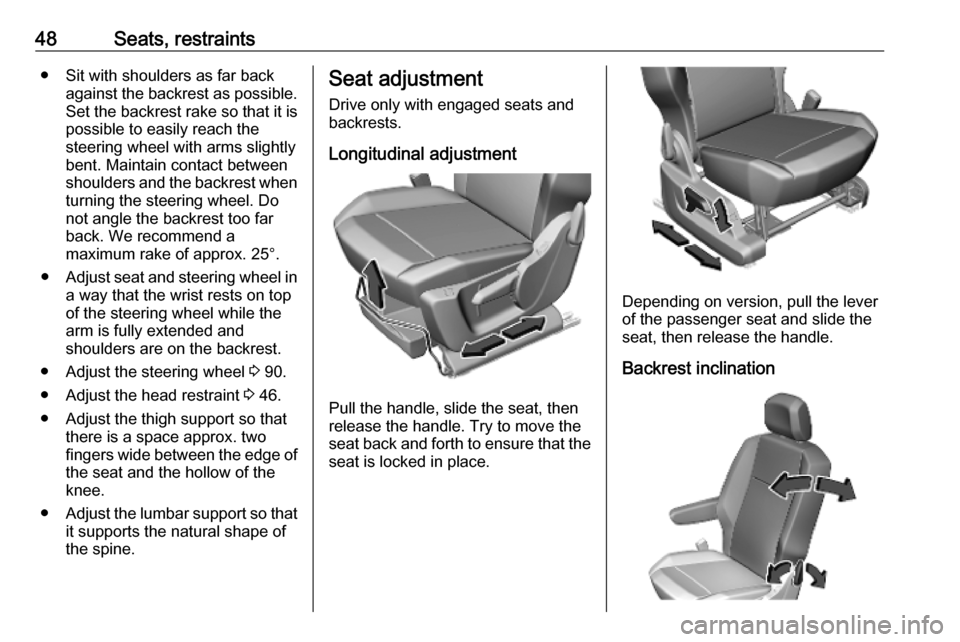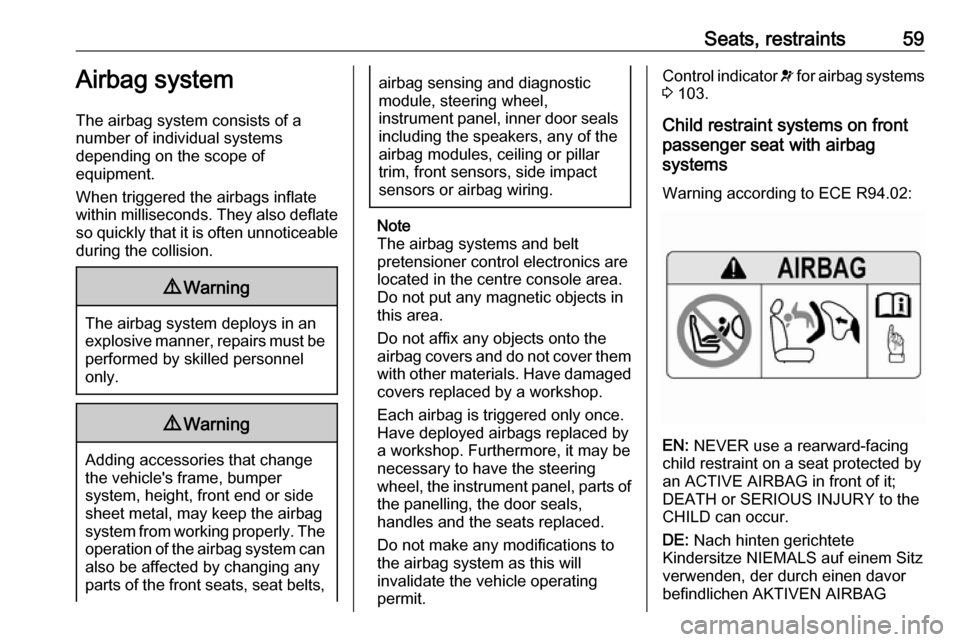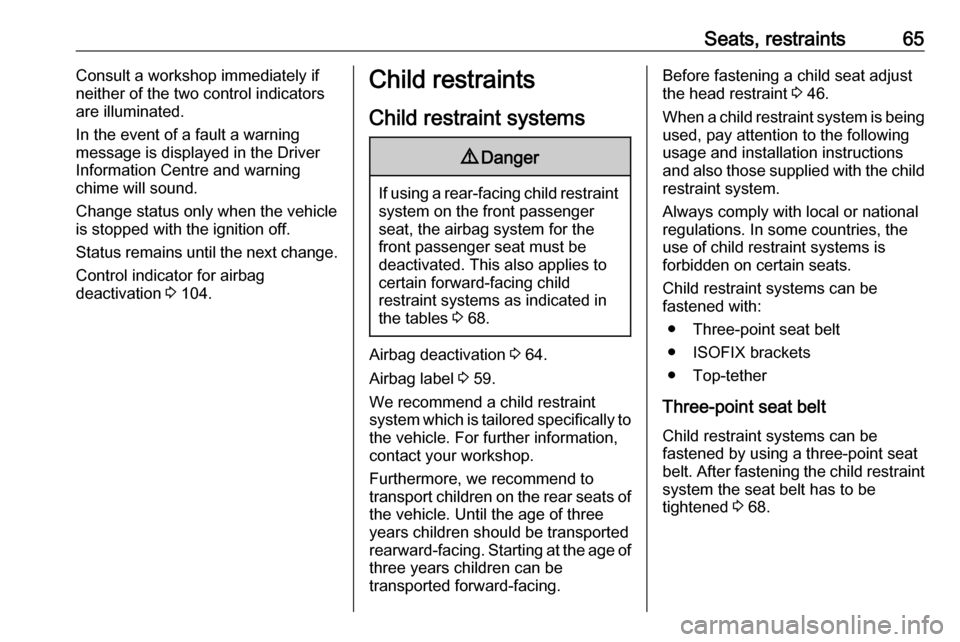ECO OPEL COMBO E 2019.1 User Guide
[x] Cancel search | Manufacturer: OPEL, Model Year: 2019.1, Model line: COMBO E, Model: OPEL COMBO E 2019.1Pages: 283, PDF Size: 10.57 MB
Page 45 of 283

Keys, doors and windows43
Press and hold c to open windows.
Press and hold e to close windows.
Release button to stop window
movement.
Overload
If the windows are repeatedly
operated within short intervals, the
window operation is disabled for
some time.
Initialising the power windows
If the windows cannot be closed
automatically (e.g. after
disconnecting the vehicle battery), a
warning message is displayed in the
Driver Information Centre.
Vehicle messages 3 117.
Activate the window electronics as
follows:
1. Close doors.
2. Switch on ignition.
3. Pull switch until the window is closed and keep pulling for
additional two seconds.
4. Push switch until the window is completely open and keep
pushing for additional two
seconds.
5. Repeat for each window.Rear windows
To partially open the rear windows, tilt the lever and push it fully to lock the
windows in the open position.
Heated rear window Operated by pressing e together
with heated exterior mirrors.
Heating works with the engine
running and is switched off
automatically after a short time.
Depending on climate control system, e is located at a different position.
Page 47 of 283

Keys, doors and windows45To reduce sunlight at the second row
seats, pull the blind upwards using
the grip and engage it at the top of the door frame.Roof
Glass panel
Sunblind
Press N at the rear: the sunblind is
opened as long as the switch is
operated.
Press N at the front: the sunblind is
closed as long as the switch is
operated.
Page 48 of 283

46Seats, restraintsSeats, restraintsHead restraints............................ 46
Front seats ................................... 47
Seat position .............................. 47
Seat adjustment ........................48
Seat folding ............................... 49
Armrest ...................................... 51
Heating ...................................... 51
Rear seats ................................... 52
Second row seats ......................52
Third row seats .......................... 53
Seat belts ..................................... 56
Three-point seat belt .................57
Airbag system .............................. 59
Front airbag system ...................62
Side airbag system ....................62
Curtain airbag system ...............63
Airbag deactivation ....................64
Child restraints ............................. 65
Child restraint systems ..............65
Child restraint installation locations ................................... 68Head restraints
Position9 Warning
Only drive with the head restraint
set to the proper position.
The upper edge of the head restraint
should be at upper head level. If this
is not possible for extremely tall
people, set to highest position, and
set to lowest position for small people.
Adjustment
Head restraints on front seats
Height adjustment
Pull the head restraint upwards or
press catch and push it downwards.
Removal
Press catch, pull the respective head
restraint upwards and remove.
Page 50 of 283

48Seats, restraints● Sit with shoulders as far backagainst the backrest as possible.
Set the backrest rake so that it is possible to easily reach the
steering wheel with arms slightly
bent. Maintain contact between
shoulders and the backrest when turning the steering wheel. Do
not angle the backrest too far
back. We recommend a
maximum rake of approx. 25°.
● Adjust seat and steering wheel in
a way that the wrist rests on top
of the steering wheel while the
arm is fully extended and
shoulders are on the backrest.
● Adjust the steering wheel 3 90.
● Adjust the head restraint 3 46.
● Adjust the thigh support so that there is a space approx. two
fingers wide between the edge of the seat and the hollow of the
knee.
● Adjust the lumbar support so that
it supports the natural shape ofthe spine.Seat adjustment
Drive only with engaged seats and
backrests.
Longitudinal adjustment
Pull the handle, slide the seat, then
release the handle. Try to move the seat back and forth to ensure that the
seat is locked in place.
Depending on version, pull the lever
of the passenger seat and slide the seat, then release the handle.
Backrest inclination
Page 54 of 283

52Seats, restraintsRear seats
Second row seats Depending on the equipment, the
rear seat backrest is divided into two or three parts. All parts can be folded
down.
Before folding rear seat backrests,
execute the following if necessary:
● Move front seats forward.
● Remove the load compartment cover 3 77.
Folding the seats 1. Push the head restraint downwards 3 46.
2. Check that the outer seat belts are
lying correctly on the backrests.
3. Pull the release lever on one or both outer sides and fold down thebackrests onto the seat cushion.
4. Depending on version, fold down the centre backrest by pulling the
loop.
5. Alternatively fold seat backrests from the load compartment: pull
lever on left or right sidewall of the
load compartment to fold the rear
seat backrests.
9 Warning
Take care when operating the rear
backrests from the load
compartment. The backrest is
Page 59 of 283

Seats, restraints57modifications to belt pretensionercomponents as this will invalidate
the operating permit of your vehicle.
Three-point seat belt
Fasten
Withdraw the belt from the retractor,
guide it untwisted across the body
and insert the latch plate into the
buckle. Tighten the lap belt regularly
whilst driving by pulling the shoulder
belt.
Loose or bulky clothing prevents the
belt from fitting snugly. Do not place
objects such as handbags or mobile
phones between the belt and your body.
9 Warning
The belt must not rest against hard
or fragile objects in the pockets of
your clothing.
Seat belt reminder X 3 103, 3 110.
Unfasten
To release belt, press red button on
belt buckle.
Centre seat belt of the secondseat row
The centre seat is equipped with a particular three-point seat belt.
Page 61 of 283

Seats, restraints59Airbag system
The airbag system consists of a
number of individual systems
depending on the scope of
equipment.
When triggered the airbags inflate
within milliseconds. They also deflate
so quickly that it is often unnoticeable during the collision.9 Warning
The airbag system deploys in an
explosive manner, repairs must be performed by skilled personnel
only.
9 Warning
Adding accessories that change
the vehicle's frame, bumper
system, height, front end or side
sheet metal, may keep the airbag
system from working properly. The operation of the airbag system can
also be affected by changing any
parts of the front seats, seat belts,
airbag sensing and diagnostic
module, steering wheel,
instrument panel, inner door seals including the speakers, any of the
airbag modules, ceiling or pillar
trim, front sensors, side impact
sensors or airbag wiring.
Note
The airbag systems and belt
pretensioner control electronics are
located in the centre console area.
Do not put any magnetic objects in
this area.
Do not affix any objects onto the
airbag covers and do not cover them with other materials. Have damagedcovers replaced by a workshop.
Each airbag is triggered only once.
Have deployed airbags replaced by
a workshop. Furthermore, it may be
necessary to have the steering
wheel, the instrument panel, parts of
the panelling, the door seals,
handles and the seats replaced.
Do not make any modifications to
the airbag system as this will
invalidate the vehicle operating
permit.
Control indicator v for airbag systems
3 103.
Child restraint systems on front passenger seat with airbag
systems
Warning according to ECE R94.02:
EN: NEVER use a rearward-facing
child restraint on a seat protected by
an ACTIVE AIRBAG in front of it;
DEATH or SERIOUS INJURY to the
CHILD can occur.
DE: Nach hinten gerichtete
Kindersitze NIEMALS auf einem Sitz
verwenden, der durch einen davor
befindlichen AKTIVEN AIRBAG
Page 66 of 283

64Seats, restraintsAirbag deactivation
The front passenger airbag system
must be deactivated for child restraint system on the passenger seat
according to the instructions in the
table 3 68. The side airbag and
curtain airbag systems, the belt
pretensioners and all driver airbag
systems will remain active.
The front passenger airbag system
can be deactivated via a key-
operated switch on the passenger side of the instrument panel.
Use the ignition key to choose theposition:OFF *:front passenger airbag is
deactivated and will not
inflate in the event of a
collision, control indicator
OFF * illuminates
continuously in the centre
consoleON Ó:front passenger airbag is
active9 Danger
Deactivate passenger airbag only
in combination with the use of a
child restraint system, subject to
the instructions and restrictions in
the table 3 68.
Otherwise, there is a risk of fatal
injury for a person occupying a
seat with a deactivated front
passenger airbag.
If the control indicator Ó illuminates
for approx. 60 seconds after the
ignition is switched on, the front
passenger airbag system will inflate
in the event of a collision.
If the control indicator * illuminates
after the ignition is switched on, the front passenger airbag system is
deactivated. It stays on while the
airbag is deactivated.
If both control indicators are
illuminated at the same time, there is
a system failure. The status of the
system is not discernible, therefore
no person is allowed to occupy the
front passenger seat. Contact a
workshop immediately.
Page 67 of 283

Seats, restraints65Consult a workshop immediately if
neither of the two control indicators
are illuminated.
In the event of a fault a warning
message is displayed in the Driver
Information Centre and warning
chime will sound.
Change status only when the vehicle is stopped with the ignition off.
Status remains until the next change.
Control indicator for airbag
deactivation 3 104.Child restraints
Child restraint systems9 Danger
If using a rear-facing child restraint
system on the front passenger
seat, the airbag system for the
front passenger seat must be
deactivated. This also applies to certain forward-facing child
restraint systems as indicated in
the tables 3 68.
Airbag deactivation 3 64.
Airbag label 3 59.
We recommend a child restraint system which is tailored specifically to the vehicle. For further information,
contact your workshop.
Furthermore, we recommend to
transport children on the rear seats of
the vehicle. Until the age of three
years children should be transported
rearward-facing. Starting at the age of
three years children can be
transported forward-facing.
Before fastening a child seat adjust
the head restraint 3 46.
When a child restraint system is being used, pay attention to the following
usage and installation instructions
and also those supplied with the child
restraint system.
Always comply with local or national
regulations. In some countries, the
use of child restraint systems is
forbidden on certain seats.
Child restraint systems can be
fastened with:
● Three-point seat belt
● ISOFIX brackets
● Top-tether
Three-point seat belt
Child restraint systems can be
fastened by using a three-point seat
belt. After fastening the child restraint
system the seat belt has to be
tightened 3 68.
Page 69 of 283

Seats, restraints67child's backbone, which is still very
weak, is under less strain in the event
of an accident.
Suitable are child restraint systems
that comply with valid UN ECE
regulations. Check local laws and
regulations for mandatory use of child restraint systems.
The following child restraints are
recommended for the following
weight classes:
● Group 0+ :
Römer Baby-Safe Plus with
ISOFIX base for children up to
13 kg
● Group I :
Römer Duo Plus ISOFIX with
ISOFIX and Top-tether for
children from 9 kg to 18 kg
● Group II, Group III :
Römer Kidfix XP with or without
ISOFIX for children from 15 kg to
36 kg
● Group III : Graco Booster for
children from 22 kg to 36 kg
Ensure that the child restraint system to be installed is compatible with the
vehicle type.Ensure that the mounting location of
the child restraint system within the
vehicle is correct, see following
tables.
Allow children to enter and exit the
vehicle only on the side facing away
from the traffic.
When the child restraint system is not in use, secure the seat with a seat belt
or remove it from the vehicle.
Note
Do not affix anything on the child
restraint systems and do not cover
them with any other materials.
A child restraint system which has
been subjected to stress in an
accident must be replaced.